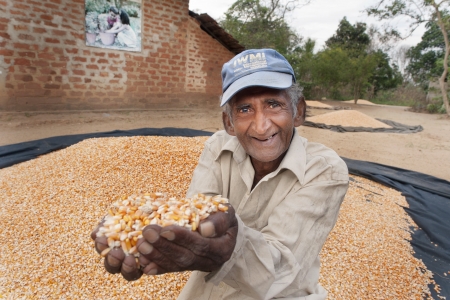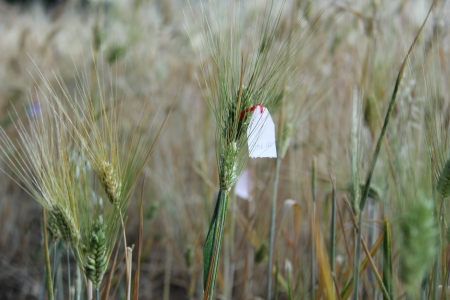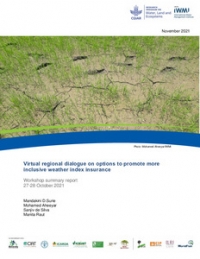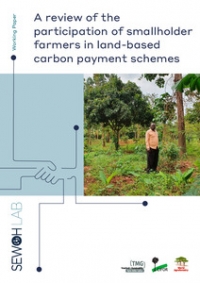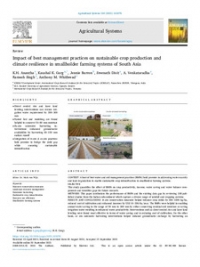A Water Pavilion side-event at the UN's Climate Change Conference (COP26) addresses tech-savvy and inclusive water management innovations that can help farming communities navigate natural disasters and build resilience to climate change
Too much water, too little water
In the last two decades, financial damages of US$2,440 billion have been caused by natural disasters, three quarters of which were related to water – either too much of it, or too little. In South Asia, over 700 million people and 190 million hectares of land have been affected by droughts and floods. Yet even such large numbers mask the scale of impact on agricultural livelihoods, and do not capture the challenges to food and nutrition security faced by vulnerable communities – particularly women, the elderly and young people – at subnational level.
Furthermore, the threat of natural disaster often compels farmers to opt for more conservative risk management strategies, deterring them from investing in advanced water management technologies and practices. In fact, climate-smart innovations can reduce the risks faced by marginal smallholder farmers.
The International Water Management Institute (IWMI), the CGIAR Research Programs on Water, Land and Ecosystems (WLE) and Climate Change, Agriculture and Food Security (CCAFS) are working with the Indian Council on Agricultural Research (ICAR) and Japan's Ministry of Agriculture, Forestry and Fisheries to convene a side-event at the COP26 Water Pavilion. 'Reinforcing climate resilience through integrated climate solutions' will focus on innovative, strategic approaches to integrate a water systems approach to manage drought and flood risks while considering the needs of the most vulnerable. The session will also consider how farming communities, the private sector and governments are responding to the challenges of mitigating and adapting to climate change.
Innovations for a climate-resilient future
IWMI/WLE and CCAFS are designing and implementing integrated climate solutions that put technology at the service of farming communities, especially the most vulnerable. These innovations seek to use big data analytics to monitor patterns of drought and flooding across regions and provide solutions that support farmers from seed to harvest.
Drought monitoring for water security
Drought is a complex phenomenon that can affect even neighboring regions very differently: for instance, a state may experience average cumulative rainfall during the monsoon, but districts within the state may suffer severe drought. With the insights provided by map-based monitoring systems that enable early warning systems, action plans can be developed and drought preparation improved for irrigated and rainfed agricultural systems. The South Asia Drought Monitoring System (SADMS) and MENAdrought projects in Jordan, Lebanon and Morocco are prime examples of using big data to help small farmers.
Flood insurance to safeguard farmers
Monitoring can also be used to 'flood-proof' agricultural livelihoods. Predetermined indexes such as rainfall, combined with river characteristics and digital elevation models, can estimate flood damage without the need for time-consuming individual assessments, providing an efficient mechanism to trigger direct compensation to farmers. The pilot for an index-based flood insurance (IBFI) scheme in India covered 150 households, 45% headed by women, and so far 12,300 farmers in India, Bangladesh and Sri Lanka have been awarded payouts totaling US$180,000.
Bundled solutions for climate resilience
Climate insurance can be incorporated into bundles that also provide seeds, fertilizers and other climate information services to farmers. Improved drought-tolerant and flood-resistant seed varieties can be supplied to farmers following geospatial assessments of their suitability, along with agricultural inputs and information on appropriate agricultural practices. Farmers can also keep abreast of weather forecasts, sent to them via SMS in local languages, so they can take the necessary precautions to protect their crops and other assets.
Scaling climate insurance and economic assessment of IBFI
IWMI research suggests that public-private partnerships are the most appropriate for developing, marketing and scaling up IBFI products. This approach would harness the skills and expertise of both public and private sectors to create products and market them, keeping in mind the challenges of effectively marketing micro-insurance products for marginalized communities. Wide-ranging collaboration will be needed; in India, IWMI has been supporting this process. More recent research based on a hypothetical case study indicates that IBFIs are economically viable for major stakeholders – farmers, insurance companies and the government.
Recommendations
Today, climate change mitigation and adaptation are synonymous with disaster risk management. Rather than isolated technical fixes, bundles of technologically powered and socially inclusive solutions that view water as a system are more likely to build resilience. A holistic approach that prioritizes the participation of women and other marginalized groups is vital to meeting the multiple, shifting challenges of climate change.
Along with community participation, political commitment and both public and private sector financial investment are key to scaling up innovations in achieving climate goals, while meeting targets under the 2030 Agenda for Sustainable Development and the Sendai Framework for Disaster Risk Reduction. Specific recommendations include:
- Decision makers should take appropriate policy measures to promote sustainable land management, integrated water resource management and climate-smart agricultural practices that help maintain ecosystem services.
- Contingency plans should be activated where indicated by the data. Where crop damage is forecast, short-duration crop varieties can be promoted to recoup losses for small farmers.
- Dissemination of information about the benefits of bundled solutions for farmers, including flood insurance schemes, should be aligned with greater transparency in contracts, improved grievance redressal mechanisms and financial support from governments to cover insurance premiums.
- Existing drought and flood monitoring systems should be refined to enable better spatial and social targeting of interventions, and early action to finance them.
'Reinforcing climate resilience through integrated climate solutions' will take place 12:00 PM-12:45 PM GMT on Wednesday, 10 November. For more information, and to watch the live stream, click here.




/index.jpg?itok=EzuBHOXY&c=feafd7f5ab7d60c363652d23929d0aee)






